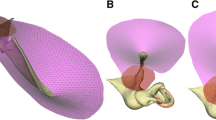Summary
-
1.
Amplitudes of middle ear structure were measured inGekko gecko, using the Mössbauer effect.
-
2.
The amplitude of the columella/extracolumella system is more or less constant up to 1 kHz and then falls off.
-
3.
A frequency-dependent lever ratio exists between the inferior process on the drum and the columella.
-
4.
Below 2 kHz the drum locations tested all had higher amplitudes than the inferior process.
-
5.
The vibration pattern of the drum is simple below 3 kHz, but breaks into at least two peaks above this frequency.
-
6.
The drum vibrates in phase at low frequencies, but at higher frequencies larger phase variations exist.
-
7.
All the above factors contribute to highly efficient impedance matching at low frequencies, but poor matching above about 4 kHz.
-
8.
The eardrum intensity response is linear at the intensities used.
Similar content being viewed by others
References
Békésy, G. von: Über die Messung der Schwingungsamplitude der Gehörknöchelchen mittels einer kapazitiven Sonde. Akust. Z.6, 1–16 (1941).
Campbell, H. W.: The effects of temperature on the auditory sensitivity of lizards. Physiol. Zool.42, 183–210 (1969).
Capranica, R. R., Frishkopf, L. S.: Responses of auditory units in the medulla of the cricket frog. J. acoust. Soc. Amer.40, 1263A (1966).
Dooling, R. L., Mulligan, J. A.: Audibility curve of the common canary. J. acoust. Soc. Amer.47, 67 (1970).
Frishkopf, L. S., Goldstein, M. H.: Responses to acoustic stimuli from single units in the eighth nerve of the bullfrog. J. acoust. Soc. Amer.35, 1219–1228 (1963).
Gaudin, E. P.: On the middle ear of birds. Acta otolaryng. (Stockh.)65, 316–326 (1968).
Johnstone, J. R., Johnstone, B. M.: Unit responses from the lizard auditory nerve. Exp. Neurol.24, 528–537 (1969).
Johnstone, B. M., Taylor, K. J.: Mechanical aspects of cochlear function. In: Frequency analysis and periodicity detection in hearing (eds. R. Plomp and G. F. Smoorenburg), p. 81–93. Leiden: A. W. Sijthoff 1970.
Johnstone, B. M., Taylor, K. J., Boyle, A. J.: Mechanics of the guinea pig cochlea. J. acoust. Soc. Amer.47, 504–509 (1970).
Kawabata, I., Ishii, H.: Fiber arrangement in the tympanic membrane. Acta otolaryng. (Stockh.)72, 243–254 (1971).
Khanna, S. M., Tonndorf, J.: Tympanic membrane vibrations in cats studied by time-averaged holography. J. acoust. Soc. Amer.51, 1904–1920 (1972).
Konishi, M.: Comparative neurophysiological studies of hearing and vocalizations in songbirds. Z. vergl. Physiol.66, 257–272 (1970).
Liff, H.: Responses from single auditory units in the eighth nerve of the leopard frog. J. acoust. Soc. Amer.45, 512–513 (1969).
Loftus-Hills, J. J., Johnstone, B. M.: Auditory function, communication, and the brain-evoked response in anuran amphibians. J. acoust. Soc. Amer.47, 1131–1138 (1970).
Manley, G. A.: Frequency sensitivity of auditory neurons in the caiman cochlear nucleus. Z. vergl. Physiol.66, 251–256 (1970a).
Manley, G. A.: Comparative studies of auditory physiology in reptiles. Z. vergl. Physiol.67, 363–381 (1970b).
Manley, G. A.: Some aspects of the evolution of hearing in vertebrates. Nature (Lond.)230, 506–509 (1971).
Manley, G. A.: Frequency response of the ear of the Tokay Gecko. J. exp. Zool.181, 159–168 (1972).
Manley, G. A., Irvine, D. R. F., Johnstone, B. M.: Frequency response of bat tympanic membrane. Nature (Lond.)237, 112–113 (1972).
Manley, J. A.: Single unit studies in the midbrain auditory area inCaiman. Z. vergl. Physiol.71, 255–261 (1971).
Patterson, W. C.: Hearing in the turtle. J. Aud. Res.6, 453–464 (1966).
Saunders, J. C., Johnstone, B. M.: A comparative analysis of middle ear function in non-mammalian vertebrates. Acta otolaryng. (Stockh.)73, 353–361 (1972)
Suga, N., Campbell, H. W.: Frequency sensitivity of single auditory neurons in the gecko,Coleonyx variegatus. Science157, 88–90 (1967).
Trainer, J. E.: The auditory acuity of certain birds. Ph. D. Thesis, Cornell University. (1946)
Werner, Y. L., Wever, E. G.: The function of the middle ear in lizards:Gekko gecko andEublepharis macularius (Gekkonoidea). J. exp. Zool.179, 1–16 (1972).
Wever, E. G., Werner, Y. L.: The function of the middle ear in lizards:Crotaphytus collaris (Iguanidae). J. exp. Zool.175, 327–342 (1970).
Author information
Authors and Affiliations
Additional information
Supported by Grant A6368 from the Canadian National Research Council, and a grant to B. M. Johnstone from the Australian Research Grants Committee. This work was carried out while the author was a Queen Elizabeth II Fellow at the University of Western Australia. I thank B. M. Johnstone for generously putting his equipment at my disposal for these experiments, and Roberta Webster and Debbie Nolte for expert technical assistance.
Rights and permissions
About this article
Cite this article
Manley, G.A. The middle ear of the Tokay Gecko. J. Comp. Physiol. 81, 239–250 (1972). https://doi.org/10.1007/BF00693629
Received:
Issue Date:
DOI: https://doi.org/10.1007/BF00693629




